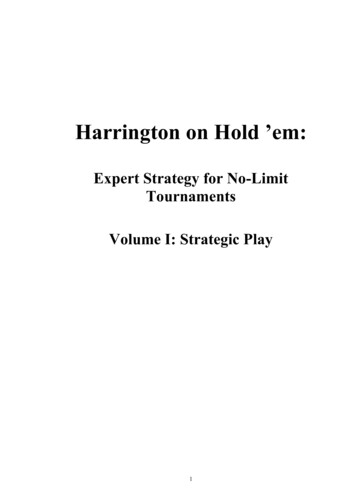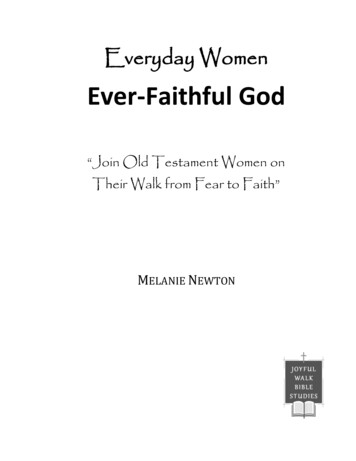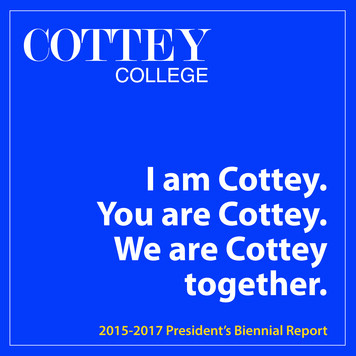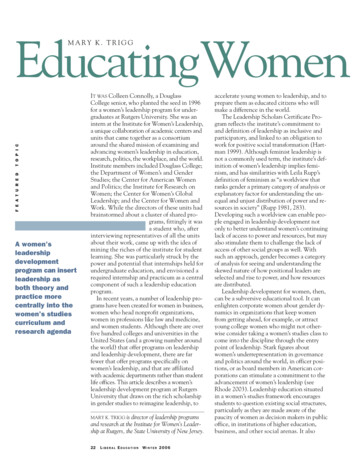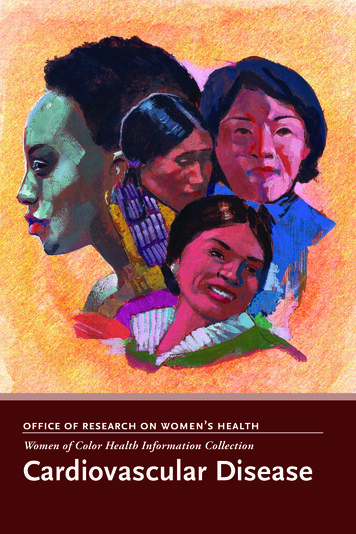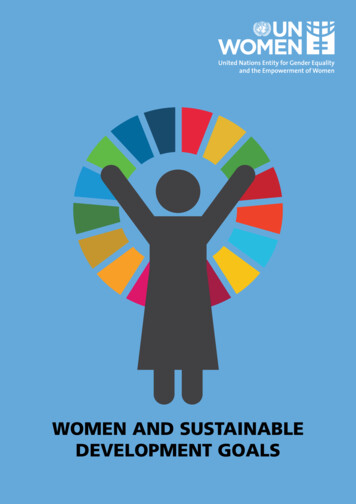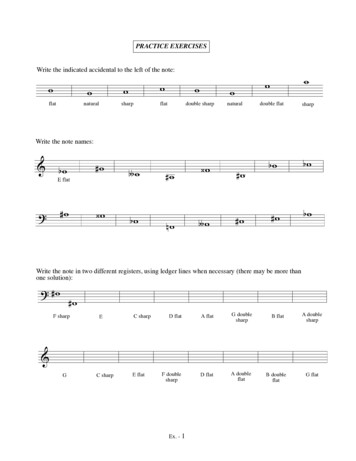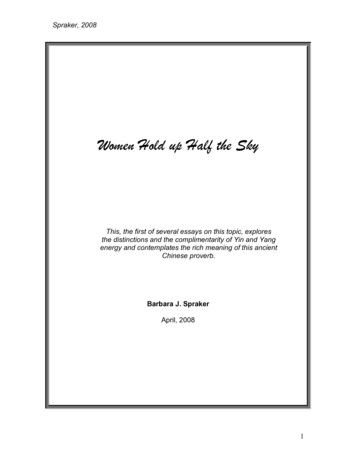
Transcription
Spraker, 2008Women Hold up Half the SkyThis, the first of several essays on this topic, exploresthe distinctions and the complimentarity of Yin and Yangenergy and contemplates the rich meaning of this ancientChinese proverb.Barbara J. SprakerApril, 20081
Spraker, 2008Women Hold up Half the SkySo claims an ancient Chinese proverb – “Women Hold up Half the Sky.” Thisamazing image doesn’t describe women sitting under the shade tree while menhold up the sky. It doesn’t suggest women are competing with men to hold upthe sky. And it doesn’t suggest there are simply more men to hold up the sky.Not at all! What it evokes is a picture of women fully bringing their unique gifts tothe task, bringing their ways of holding up the sky.Image is the soul speaking to us – rich, subtle, nuanced, pictures worth athousand words. The temptation is to let the image be, and speak itself to eachperson.Women Hold up Half the Sky– end of story.At the same time we yearn to explore the deeper meaning of image, to share ourinterpretations, to discern collective, not just individual meaning. When we sharedifferent viewpoints, several paths emerge.One is the path of wholeness and commitment to the greater good, theawareness of individual effort for collective benefit. After all, it is not the sky“above my house” I am holding; it is the atmosphere we share - all of us thatinhabit this planet, this blanket that surrounds the planet as a whole, this contextin which we all, male and female, exist.Another path related to this greater good, requires us to “let go” of our ego andlay claim to our deeper personal power, rooted in our unique gifts, perspectiveand passions, as well as to our place in the universal wisdom stream. This pathenables us to understand that while we are individuals doing our work, our role inholding up the sky is not about ego, it is about the common good. So we “let go”of comparison and competition and listen inside for that place where our uniquecontributions are called for. When we are centered in our personal power, weare connected – connected to our highest vision, to others with whom we shareour task, and to the continuum of wisdom and insight that is our birthright.A third path recognizes these different energies that combine in this collectiveeffort. Women are not men in drag. Some of the energies are active, expansive,conscious of the self. Others are responsive, conservative, conscious of theenvironment. Such differences lighten the burden.A fourth path is one that sees clearly that this task is dynamic, not static. Just asthose holding up the sky have individual gifts and energies, so the sky iscontinually changing, storm clouds gather and disperse, winds arise and subside,2
Spraker, 2008the sun warms the air and disappears and coolness returns. So those who are“holding the sky” are engaged not in holding tight to a pillar, but are engaged in adynamic, interdependent, co-creative dance - in relationship with colleagues andwith the sky itself in its continual changes.And, it is not just women. The other half of the sky is held up by men. Thisdoesn’t come into the world as a new idea.The ancient philosophy of Taoism provides a powerful and profound perspectivefor understanding the essence of these paths - of wholeness, ofinterdependence, and of the different energies required for “holding up the sky.”All things connote the Yin and the Yang,” Taoism teaches. “And the Yin and theYang keep acting upon each other / And thus things keep changing and unifyingthemselves.” (The Book of Tao, Chapter 42) The interaction of Yin and Yangcreate the continual, emergent process of transformation.This Yin and Yang described in the Tao Te Ching are described by mythologist,Joseph Campbell as the sunny side of the stream and the shady side of thestream.Yang is of the sunny side; Yin, the shady. On the sunny side thereis light, there is warmth, and the heat of the sun is dry. In the shade,there is the cool, rather, of the earth, and the earth is moist. Dark,cold, and moist; light, hot, and dry: earth and sun in counter-action.These are associated, further, with the female and the male as thepassive and active principles. There is no moral verdict here intended;neither principle is “better” than the other; neither “stronger” than theother. They are the two equally potent grounding principles on whichall the world rests, and in their interaction they inform, constitute,and decompose all things.” (Campbell, 1972, p. 119)In her research into cross-cultural mythology and symbols, Angeles Arrienreveals that this distinction of complementary energies is part of many culturaltraditions.In Oriental cultures, the Emperor archetype represents dynamic, initiatory power knownas Yang energy. Jungian psychology refers to this symbol as a representation of theanimus or masculine energy. In Greek mythology, this symbol is Zeus, the father or thepatriarch. (Arrien, 1997, p. 37)The Empress archetype is the principle of love with wisdom. “The Greeks referred to thissymbol as Demeter, the Earth Mother. . . . In Jungian psychology, she is the anima, thefeminine nature.” She is the “Goddess principle, or what the Orientals would refer to asthe power of Yin energy.” (Arrien, 1997, p. 33)Fritjof Capra, physicist and systems theorist, elaborates on these distinctions anddraws out profound implications. He interprets Yin energy as “responsive,consolidating, cooperative activity, and Yang energy as aggressive, expanding,competitive activity.” (Capra, 1982, p, 38) Further, Capra sees Yin and Yang3
Spraker, 2008energy as related to two modes of consciousness, two different kinds of knowing.“The rational and the intuitive are complementary modes of functioning of thehuman mind. Rational thinking is linear, focused and analytic. It belongs to therealm of the intellect, whose function it is to discriminate, measure andcategorize. Thus rational knowledge tends to be fragmented. Intuitiveknowledge, on the other hand, is based on a direct, nonintellectual experience ofreality arising in an expanded state of awareness. It tends to be synthesizing,holistic, and nonlinear.” (Capra, ibid.) He identifies these associations with Yinand hus Capra draws us into a deeper reflection on the distinctions between Yin andYang energy. His perspective is that for the past three centuries, our culture hasconsistently favored the Yang over the Yin energies, and that our economic,social and political structures reflect and reinforce this imbalance.Those of us living on this planet today who have roots in western historicaltraditions, have grown up within this economic, social, political culture. Thissuggests that beliefs such as: rational thinking is of greater value than intuition, competition is superior to cooperation, science is to be trusted more than religion, initiative is superior to responsiveness are embedded in our own basic assumptions. (Capra, p. 39) And, it nudges us toexpanded awareness that our culture is way out of balance!These different perspectives are not abstract concepts. They play out in ourdaily lives at work, at home, and in the community. Susan illustrates thedistinctions in her story of terminating employees. General manager of an Asianmanufacturing corporation, Susan noted that she and her male counterpartsused the same corporate guidelines for terminating employees when reductionsin staff were necessary.“There’s a big difference, though,” she said, “in how we interpret and carry out thoseguidelines. I see my male colleagues explain the situation to the employees affected.They describe the exit process and collect the employees’ keys. The task isaccomplished and they move on to their next project. I just don’t handle it the same way.I spend more time with the individuals. I invite them to talk about the impact on the restof their life. I listen for their primary concerns and offer any help I can provide, which maysimply be listening with empathy.”4
Spraker, 2008Recent research by scholars in two quite different disciplines provides insight intospecific ways in which Yin and Yang energy manifests and suggests possibleways Yin energy uniquely “holds up the sky” in ways that benefit all.In her research into developing personal identity and maturity in moral judgment,Carol Gilligan focused on women. Her findings led to her development of atheory of morality based on notions of responsibility and care, a sense ofrelationship, a sense of connection. This contrasted dramatically with the resultsof Lawrence Kohberg’s research, conducted with young men, which found thatmoral maturity centered on objectivity and the value of abstract laws anduniversal principles for resolving ethical conflicts. Women, Gilligan found,consistently expressed a wish not to hurt others and the hope that in moralitycould be found a way of solving conflicts so that no one would be hurt. (Gilligan,1993, p. 65) Women give much attention to context and dialogue and pursuemutual understanding and resolution rather than depending on abstractprinciples.Gilligan concluded that, for men, the definition of self comes through a process ofseparating self from the world and others, and for women, the self is delineatedthrough connection to others, the world and the situation in question. (Gilligan,p. 37.)How this expands our understanding of dealing with ethical issues! Yes, weneed laws and principles for resolving ethical conflict. But that is only oneavenue. Many conflicts are more effectively resolved through dialogue, throughmutual understanding, through consideration of the context.Turning to another discipline for perspectives on the distinctions between Yin andYang energy, we find scientific studies that reveal that the impact of stress on thehuman body is experienced quite differently by men and by women.The discovery that women respond to stress differently than men was made in aclassic "aha" moment shared by two women scientists who were talking one dayin a lab at UCLA."There was this joke that when the women who worked in the lab were stressed,they came in, cleaned the lab, had coffee, and bonded", says Dr. Laura Klein. "When themen were stressed they holed up somewhere on their own. I commented one day tofellow researcher Shelley Taylor that nearly 90% of the stress research is on males. Ishowed her the data from my lab, and the two of us knew instantly that we were ontosomething." (Professional Women’s Network)(http://www.pwn.org/content.asp?ID 1564&I 2548)The subsequent study conducted by Taylor, Klein and colleagues (Taylor, et al.,2000) argues that while fight or flight may be an effective adaptive response formales, females’ responses are marked more by a pattern they call tend andbefriend. “Tending involves nurturant activities designed to protect the self and5
Spraker, 2008offspring that promote safety and reduce distress; befriending is the creation andmaintenance of social networks that may aid in this process.” (p. 411) Theyfound that research on human males and females shows that under conditions ofstress, the desire to affiliate with others is substantially more marked amongfemales than among males. “In fact, it is one of the most robust genderdifferences in adult human behavior, other than those directly tied to pregnancyand lactation, and it is the primary gender difference in adult human behavioralresponses to stress.” (p. 418)Authors of the study conclude that the “tend and befriend” response of women tostress is not only very real, but also very healthy. “The present analysis issuggestive of health implications for females. If a downregulated stressresponse in females produces relaxation and affiliation, this may help to explainthe 7 ! nonspecific years that women live longer than men.” (p. 424) Authors ofthe report also note that their analysis “suggests important implications for socialsupport processes.” (ibid.)Once again, examining the distinctions between Yin and Yang energy, andhonoring the unique characteristics of Yin energy, offers huge potential in termsof improving individual and collective health and well being. Suppose Yin energywas represented proportionately in situations of conflict, in confrontations, inemergency situations. Already in medical care, the value of support systems isseen as critical to the recovery of patients.Differences between Yin and Yang energy are described in countless ways bywomen in stories of their every day experience.“I know there are principles, and even a whole industry, focused on how todo effective fundraising,” said Sarah, “but when a friend needed supportfor a project she was working on, I invited three other couples for dinnerand made soup. At the end of the evening we had raised 2000.”While I think of attorneys as “by the book” professionals, when Icontracted with them to create a training project, I never considered aformal “needs assessment” survey, explained Barb. Instead we had tworoundtable (literally) brown bag lunches and I listened while they talkedabout what they really needed and what was most important to developthrough the training.”What happens when half of those holding the sky are excluded? As Caprareminds us “it is easy to see that our society has consistently favored the Yangover the Yin.For the past several hundred years Western science and its manifestation inindustrial society has spawned a world view of prediction and control, envisionedas division of labor, hierarchical communication and power, discrete disciplines,6
Spraker, 2008projects and tasks. And for centuries prior to this, monarchies, empires andfeudal systems manifested Yang energy, an energy that is assertive,externalized, hierarchical, oriented to power over others and which routinely usesforce to achieve desired results.The cumulative results of this Yang energy, trying to dance without its partner,have currently riveted our attention. While the benefits of scientific discovery,industrial production and technological innovation are manifold, the consequentcosts are literally killing us. The air we breathe and the water we drink arepolluted. The strategy of war for solving conflict simply escalates the conflict,increases fear, and devastates families, cities and nations.Yang energy is inadequate simply because it is incomplete. It is half of a whole.As the driving force for hundreds of years, it is embedded in a mechanisticworldview that is incapable of creating a holistic, sustainable world.Reductionistic analysis and linear, step-by-step thinking dominate. Problems arebroken into parts that can be more easily addressed. Yang energy incorporatesa belief in “objectivity,” an assumption that “I” am outside the system, able toobserve what is happening rationally, with clear perception, and makejudgments untainted by personal bias or emotion. I can use quantifiable methods to support my objective approach. I can pursue technological innovations as discrete products andprocesses, separate from potential use or impact. I can develop productivity improvements with the only criteria that theyincrease our bottom line results. I can promote research and new product development without concernabout potential impact unless specific constraints apply. Theseconstraints come from “outside.”Coming full circle, Western physicists are now describing a world that looks muchlike the one described thousands of years ago by the ancient Taoists. During thelast century, experiments in the atomic and subatomic world brought scientists tothe unexpected reality that the atoms, so long considered the solid buildingblocks of matter, consisted, in fact, of space within which tiny particles – theelectrons – moved around the nucleus. (Capra, 1983, p. 78). Out of the dramaticdiscoveries of quantum physicists during the early decades of the 20th century, anew worldview emerged characterized as holistic, organic, ecological, systemic.Physicists shifted from describing matter as composed of basic building blocks,to describing it as a complex and dynamic web of interrelationships (p. 81).These interrelationships carry us back to the idea of cooperation between Yinand Yang energy.Carriers of Yin energy, we have big work to do. As Yin energy becomes moreand more active in this dance of holding up the sky, adding the emphasis onrelationship and interconnectedness, on nurture and development, on intuitive7
Spraker, 2008ways of knowing, the dance will become richer and more powerful. We mayquite possibly become smart enough to truly create a world that works for all, thatcontinually recreates and regenerates itself for the greater good.If women are to bring their gifts to “holding up the sky,” we must not neglect thedynamic nature of our work; we are engaged in a co-creative dance. These Yinand Yang energies represent two poles of continual interaction, the process ofcontinual transformation. In his last book, Alan Watts, American philosopher, incollaboration with Al Chung-liang Huang, describe Yin and Yang as principlesand explain the key to the relationship between Yin and Yang as mutual arisingor inseparability. (Watts, 1875, p. 22) Yin and Yang are like the “different, butinseparable, sides of a coin, the poles of a magnet, or pulse and interval in anyvibration.” (p. 23) Watts acknowledges that it is difficult for the Western mind toeasily understand that the void is creative or that being comes from nonbeing.“ . . .[T]he art of life,” they remind us, “is not seen as holding to Yang andbanishing Yin, but as keeping the two in balance, because there cannot be onewithout the other.” (p. 21) Transformation and change are continual and flow fromthe interaction of Yin and Yang.While archeology reveals actual, and extended, periods of time when such adynamic, interactive, interdependent way of life existed (Eisler, 1988. Min Jiayin,ed., 1995) this view has been largely buried for many hundreds of years. Nevercompletely destroyed, it has, nevertheless been barely, and fleetingly, visibleover centuries of time.As Fritjof Capra wisely reminds us, “In human biology masculine and femininecharacteristics are not neatly separated but occur, in varying proportions, in bothsexes. Similarly, the Chinese ancients believed that all people, whether men orwomen, go through Yin and Yang phases. The personality of each man andeach woman is not a static entity but a dynamic phenomenon resulting from theinterplay between feminine and masculine elements. (Capra, p. 36) In fact, in theclassic Yin/Yang symbol, the essence of each element is included in the other, oras Carl Jung described it, every woman has her animus and every man hisanima qualities. We must support our own wholeness as we support thewholeness of our world.After all these words, let us return to the image.Women Hold up Half the SkyLet it speak to you as you contemplate its meaning for you.8
Spraker, 2008ReferencesArrien, A. (1997). The Tarot Handbook: Practical applications of ancient visualsymbols. New York, NY: Jeremy P. Tarcher/Putnam.Berkowitz, G. (2007 Networker Archive). UCLA study on friendship amongwomen. Professional Women’s Network. Retrieved November 18, 2007from the “World Wide Web: http://www.pwn.org/content.asp?ID 1564&1 2548Campbell, J. (1973). Myths to live by. New York, NY: Bantam Books.Capra, F. (1983). The turning point: Science, society, and the risingculture. New York, NY: Bantam BooksEisler, R. (1988). The chalice & the blade: Our history, our future. SanFrancisco, CA: HarperSanFrancisco.Gilligan, C. (1993). In a different voice: Psychological theory and women’sdevelopment. Cambridge, MA: Harvard University Press.Min Jiayin, ed. (1995). The chalice and the blade in Chinese culture: Genderrelations and social models. Beijing: China Social Science Publishing House.Taylor, S. E., Klein, L.C., Lewis, B. P., Gruenewald, T. L., Gurung, R.A.R.,& Updegraff, J. A. (2000). Female responses to stress: Tend andbefriend, not fight or flight. Psychological Review, 107 (3) , 411 – 429.Watts, A. and Al Chung-liang Huang. (1975). Tao, the watercourse way. NewYork, NY: Pantheon Books.The book of Tao and The. (G. Zhengkun, Trans.) Peking University (2006)9
themselves.Ó (The Book of Tao, Chapter 42) The interaction of Yin and Yang create the continual, emergent process of transformation. This Yin and Yang described in the Tao Te Ching are described by mythologist, Joseph Campbell as the sunny side of the stream and the shady side of the stream. Ya
